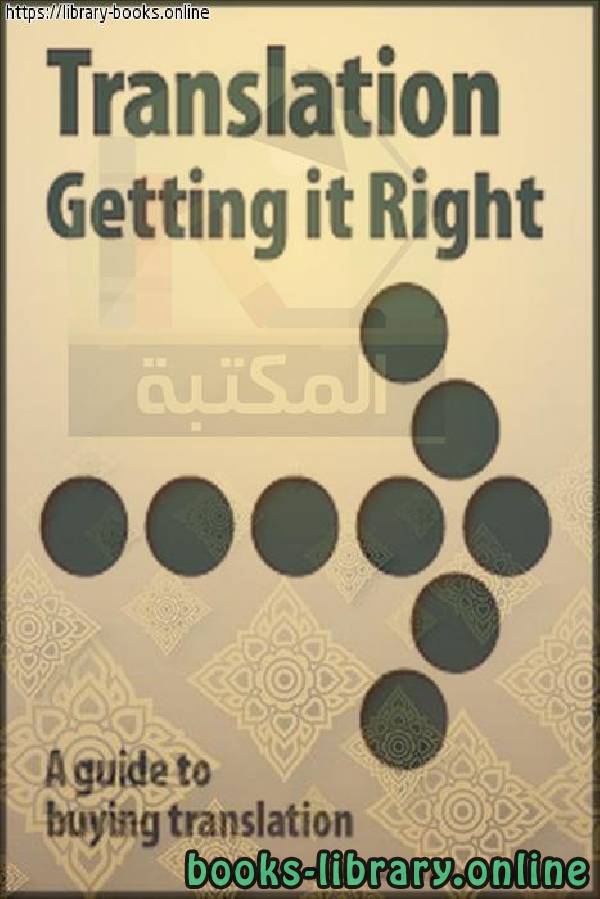📘 قراءة كتاب Translation Getting it Right أونلاين


هذا القسم يحتوى علي كل ما يخص الترجمة وعلومها
التَّرْجَمَة أو النَّقْل هي عملية تحويل نص أصلي مكتوب (ويسمى النص المصدر) من اللغة المصدر إلى نص مكتوب (النص الهدف) في اللغة الأخرى. فتعد الترجمة نقل للحضارة والثقافة والفكر.
تنقسم الترجمة إلى ترجمة كتابية وتحريرية ونصية وترجمة فورية وشفوية وسماعية.
لا تكون الترجمة في الأساس مجرد نقل كل كلمة بما يقابلها في اللغة الهدف ولكن نقل لقواعد اللغة التي توصل المعلومة ونقل للمعلومة ذاتها ونقل لفكر الكاتب وثقافته وأسلوبه أيضاً، لكن اختلفت النظريات في الترجمة على كيف تنقل هذه المعلومات من المصدر إلى الهدف، فوصف جورج ستاينر نظرية ثالوث الترجمة: الحرفية (أو الكلمة بالكلمة) والحرة (الدلالة بالدلالة) والترجمة الأمينة.
وتعتبر الترجمة فناً مستقلاً بذاته حيث أنه يعتمد على الإبداع والحس اللغوي والقدرة على تقريب الثقافات وهو يمكن جميع البشرية من التواصل والاستفادة من خبرات بعضهم البعض. فهي فن قديم قدم الأدب المكتوب. فقد تم ترجمة أجزاء من ملحمة جلجامش السومرية، من بين أقدم الأعمال الأدبية المعروفة، إلى عدة لغات آسيوية منذ الألفية الثانية قبل الميلاد.
ومع ظهور الحواسب، جرت محاولات لاستخدام الحاسوب أو ترجمة النصوص من اللغة الطبيعية بالترجمة الآلية أو لاستخدام الحاسوب كوسيلة مساعدة للترجمة، الترجمة بمساعدة الحاسوب.
Translation is the communication of the meaning of a source-language text by means of an equivalent target-language text. The English language draws a terminological distinction (not all languages do) between translating (a written text) and interpreting (oral or sign-language communication between users of different languages); under this distinction, translation can begin only after the appearance of writing within a language community.
A translator always risks inadvertently introducing source-language words, grammar, or syntax into the target-language rendering. On the other hand, such "spill-overs" have sometimes imported useful source-language calques and loanwords that have enriched target languages. Translators, including early translators of sacred texts, have helped shape the very languages into which they have translated.]
Because of the laboriousness of the translation process, since the 1940s efforts have been made, with varying degrees of success, to automate translation or to mechanically aid the human translator. More recently, the rise of the Internet has fostered a world-wide market for translation services and has facilitated "language localization".
Contents
1 Etymology
2 Theories
2.1 Western theory
2.2 Other traditions
2.2.1 Near East
2.2.2 Asia
2.2.3 Islamic world
3 Fidelity and transparency
3.1 Equivalence
3.2 Back-translation
4 Translators
4.1 Interpreting
4.2 Sworn translation
4.3 Telephone
4.4 Internet
4.5 Computer assist
5 Machine translation
6 Literary translation
6.1 History
6.2 Modern translation
6.3 Poetry
6.4 Book titles
6.5 Plays
6.6 Chinese literature
6.7 Sung texts
6.8 Religious texts
6.9 Science fiction
7 Technical translation
The English word "translation" derives from the Latin word translatio, which comes from trans, "across" + ferre, "to carry" or "to bring" (-latio in turn coming from latus, the past participle of ferre). Thus translatio is "a carrying across" or "a bringing across": in this case, of a text from one language to another.
Some Slavic languages and the Germanic languages (other than Dutch and Afrikaans) have calqued their words for the concept of "translation" on translatio.
The Romance languages and the remaining Slavic languages have derived their words for the concept of "translation" from an alternative Latin word, traductio, itself derived from traducere ("to lead across" or "to bring across", from trans, "across" + ducere, "to lead" or "to bring")]
The Ancient Greek term for "translation", μετάφρασις (metaphrasis, "a speaking across"), has supplied English with "metaphrase" (a "literal", or "word-for-word", translation)—as contrasted with "paraphrase" ("a saying in other words", from παράφρασις, paraphrasis). "Metaphrase" corresponds, in one of the more recent terminologies, to "formal equivalence"; and "paraphrase", to "dynamic equivalence".]
Strictly speaking, the concept of metaphrase—of "word-for-word translation"—is an imperfect concept, because a given word in a given language often carries more than one meaning; and because a similar given meaning may often be represented in a given language by more than one word. Nevertheless, "metaphrase" and "paraphrase" may be useful as ideal concepts that mark the extremes in the spectrum of possible approaches to translation
Translation
Getting it Right
If you’re not a linguist
yourself, buying translations
can be frustrating.
The suggestions in this guide
are aimed at reducing stress
and helping you get the most
out of your translation budget.
Q: Translation, interpreting
— what’s the difference?
A: Translators write;
interpreters speak.
If you’re working with written documents — a user
manual for your German customers, billboards for a sales
campaign in Argentina, reports filed in Chinese by your
new subsidiary in Shanghai that you must read and
understand — you need a translator.
If you want to interact with people in a foreign
language on the spot — a lab tour with Mexican
visitors, a board meeting in Japan, a parents’ evening
with a family recently arrived from Romania — you
need an interpreter.
free translation pdf
translate pdf file to arabic
translate pdf file from english to arabic
translate word document from english to arabic
pdf to word
free translation documents
online translation documents
pdf translator software
سنة النشر : 2015م / 1436هـ .
حجم الكتاب عند التحميل : 0.2MB .
نوع الكتاب : pdf.
عداد القراءة:
اذا اعجبك الكتاب فضلاً اضغط على أعجبني و يمكنك تحميله من هنا:

شكرًا لمساهمتكم
شكراً لمساهمتكم معنا في الإرتقاء بمستوى المكتبة ، يمكنكم االتبليغ عن اخطاء او سوء اختيار للكتب وتصنيفها ومحتواها ، أو كتاب يُمنع نشره ، او محمي بحقوق طبع ونشر ، فضلاً قم بالتبليغ عن الكتاب المُخالف:
 قبل تحميل الكتاب ..
قبل تحميل الكتاب ..
يجب ان يتوفر لديكم برنامج تشغيل وقراءة ملفات pdf
يمكن تحميلة من هنا 'http://get.adobe.com/reader/'


 منصّة المكتبة
منصّة المكتبة 